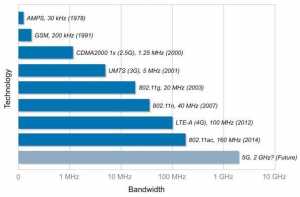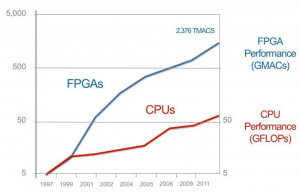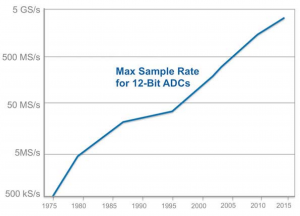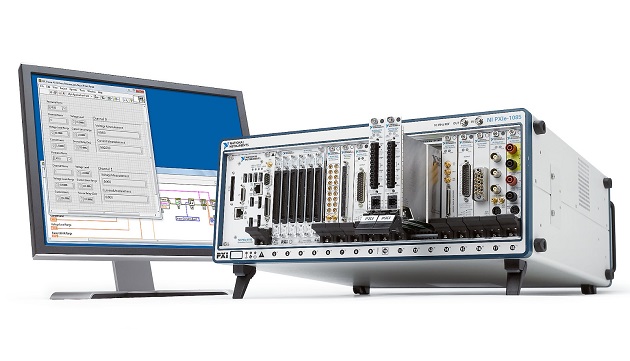Today’s microwave instrumentation market is quite complex. For one, it is nothing like the market of the 80s and noughties where the manufacturer who made the best microwave transistors won. During the two decades between the 80s and the early 2000s, test and measurement firms built instrumentation that blazed the trail of characteristics like noise floor, linearity performance and frequency range. Some of the critical innovations during this era included advances in hybrid microcircuit technology, synthesizer tuning time, and phase noise.
However, with advancements in the microwave technology and the T&M industry, the biggest development that we’ve seen over the last decade is wider instantaneous bandwidth. Not surprisingly, the evolution of the wireless industry had a substantial effect on the market requirements and hence the capabilities of modern RF signal generators and analyzers.
1G to 5G and Beyond:
There is no hiding the fact that the wireless communication industry has helped in driving tremendous innovation in signal-analyzer technology. But, the real question is, how much? That question is clearly answered upon a closer look at the rapid increase in the channel bandwidth of modern wireless standards, as is depicted in the graph below. The graph below makes it very clear that AMPS or 1G communication technology consumed a bandwidth of around 30 kHz. Similarly, GSM or 2G consumed 200 kHz and the UMTS channels or 3G consumes 5 kHz. See Fig 1.

Just like the Moore’s law for transistors on an IC, in the communication world, the Shannon Hartley theorem has held its own. The theorem model suggests that capacity is a linear function of bandwidth (not accounting for multiple antenna technology). This means that:
Capacity = Bandwidth × log2 (1 + SNR)
Apart from 2G, 3G, and 4G connections, the widespread development of 802.11ac devices also helped in the evolution of testing equipment. It was for the first time that the wireless industry had created a standard that was both widely used and was much ahead of the capabilities of RF signal generators and analysers of that period. It was a wakeup call to instrumentation companies around the world and demanded new testing equipment, which ultimately accelerated the development of wider bandwidth test and measurement equipment.
As things stand today, and with the type of instrumentation that we have at our disposal, the next major milestone for RF equipment manufacturers seems to be the 5th generation of cellular devices – 5G. With a global deployment date of 2020, 5G implementation is knocking on our doors and the need to deliver testing equipment that can satiate 5G’s massive bandwidth requirement of 2 GHz is greater than ever before. Fortunately, the big T&M firms seem ready for the challenge as almost all of them have already rolled out products that can aid 5G testing.
Achieving the 2 GHz of instantaneous bandwidth is a major milestone even by the standards of the T&M industry’s bigwigs.
Making it All Possible:
While achieving a bandwidth of 2 GHz is surely a monumental task for T&M firms, it calls in action the most famous law in electronics’ world- the Moore’s law. In 1968, Gordin E Moore predicted that the transistor density on an integrated circuit would increase two fold every two years- this means that as time passes, we’ll witness an unprecedented increase in computing capabilities. And, modern day computing surely seems to be able enough to deliver the goods that a 2 GHz bandwidth might require. Here is a graph that shows how computational technology has increased over the years.
However, if we were to think that an increase in CPU and FPGA performance alone will be enough to meet the huge requirements of 5G testing, we won’t be looking at the complete picture. Apart from computational horsepower, Analog to Digital Converters have also seen an upward trend in terms of sample rate. The graph below summarises that trend: See Fig 2.

Consider, for example, the maximum available sample rate of 12-bit ADC technology versus time (Fig. 3).

In 1975, a 12-bit ADC with 2-µs settling time (approximately 500 ksamples/s, though not an exact corollary) was considered state of the art. Today, the fastest sampling 12-bit ADCs hit rates greater than 2 Gsamples/s, a feat that’s powering some of the widest-bandwidth signal analyzers in the industry.

“Enhanced mobile broadband is a major topic in the ongoing 5G discussions, with peak data rates in the Gbit/s range and average user data rates of 100 Mbit/s. To achieve these data rates wider signal bandwidths of 500 MHz, 1 GHz and even up to 2 GHz are considered, only available at higher frequencies sub 6 GHz and beyond. To enable the industry to study wider bandwidths at higher frequencies, Rohde & Schwarz implemented a unique 2 GHz modulation bandwidth in the R&S SMW200A vector signal generator enabling 5G signal evaluation up to 40 GHz carrier frequency,” said Andreas Roessler, Technology Manager, Rohde & Schwarz in a blog post.
The Need for RF Testing:
Radio frequency compliance is a mandatory requirement in most international markets including the EU, USA, Canada, Australia and Asia. If you manufacture wireless devices or incorporate wireless devices into your end product, you must comply with the regulations of your intended markets, otherwise your products cannot be legally sold.
So, any device that is dependent on the RF bandwidth which includes electromagnetic waves from 3 kHz to 300 GHz, needs to be tested for several factors before it can be landed in the market for consumer use. You will be amazed to know just how many devices operate between those frequencies that you use almost every day, from common gadgets like smartphones to high purpose space communication devices.
This means that the market for both RF devices and RF test equipment is gigantic and it should come as no surprise that every firm wants a share of that pie.
Challenges in RF Testing and How to Overcome Them:
While developing wireless devices is certainly a challenging task, given the constant trade-offs and tight constraints, RF testing is inevitable. Governments around the world have made it a regulation and wireless devices have to pass the testing litmus before reaching the hands of the consumers. Keysight Technologies, in a blog test identified the three biggest challenges that face RF testing and gave possible solutions to all of them. The challenges according to Keysight are:
Ensuring Compliance with Strict Regulations: “Mobile data and voice services have a constant need for increased channel capacity, and the same is generally true for wireless LAN. Developers are meeting these needs using a variety of techniques, each of which makes transmitter testing more challenging,” reads the Keysight blog.
According to Keysight, multicarrier and channel schemes or extensions like MIMO and carrier aggregation bolster these complications, and since these techniques equate or exceed the standards and regulations governing them (in regards to complexity), setting up an analyzer making compliant measurements contains a whole other set of challenges. In most cases, it’s impractical to manually set up certain signal analysis types, especially for making demodulation and standard-compliant measurements.
General and Standard-Specific Measurements: As per Keysight, although dedicated transmitter testers are available for a variety of different wireless standards, they are generally focused on manufacturing or pilot production. In contrast, development and troubleshooting require a wider range of measurements that goes beyond simply verifying the performance and compliance of complete products. So, Signal analyzers that perform necessary spectrum measurements can be augmented at the time of purchase or later using software upgrades.
Electromagnetic Interference (EMI) Problems: “EMI is an ever-present concern for wireless engineers who are trying to comply with regulations and also ensure their designs will coexist in a dense spectral environment. While formal certification testing is essential, it occurs very late in the development process, putting a new product at risk for schedule delays,” says the Keysight blog.
Next-Generation RF Instruments:
Now that we’ve understood the evolution of RF instrumentation, it neatly puts us in a place where we can start the discussion of designing next generation RF equipment. One thing which is clear is that only having a faster ADC is part of the puzzle and there are more things beyond that realm that need to be achieved for the facilitation of future instruments. For one, there are challenges of flatness and linearity that need to be addressed which would require constant innovation in signal processing and Analog Design.
Apart from innovation in signal processing, the other challenge is to address the horsepower required for signal processing to convert into something that is of real value. Innovations in CPUs and FPGAs will have to take care of that and make sure that devices have ample horsepower to run complex tasks. And beyond the realm of innovation in just hardware, the software part of RF instrumentation is an area that holds the most promise and potential- and firms should continue investing in software in the future.








